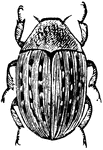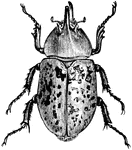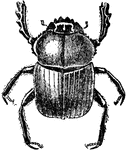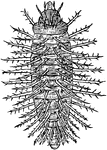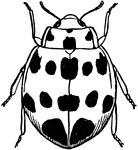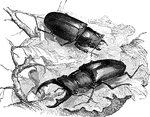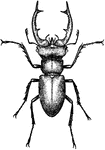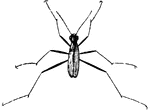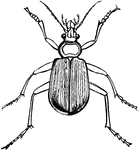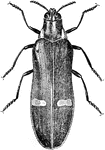
Metallic Beetle
"The Sternoxi include the Metallic Beetles, Buprestidae the most gorgeous of the coleopterous families.…

Metallic Beetle Larva
"The Sternoxi include the Metallic Beetles, Buprestidae the most gorgeous of the coleopterous families.…
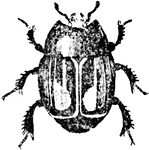
Mimic Beetle
"The Mimic Beetles seldom exceed one-third of an inch in length, and are of very solid consistence,…

Pine Beetle Stages
This illustration shows the destructive pine-bark beetle: a, adult beetle, enlarged; b, adult, natural…

Rose Beetle (Cetonia Aurata)
"The rose-beetle frequents roses especially, of which it eats the petals and stamens. They fly by day…

Larva of Rose Beetle (Cetonia Aurata)
"It is found in rotten wood, and often in ants' nests. When it has acquired its full development, it…

Sacred Beetle
"Many of the dung beetles, among which the Sacred Beetle of the Egyptians, Scarabus Aegyptiorum,…
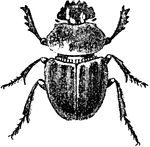
Sacred Beetle
"The Sacred Beetle of Egypt, Ateuchus sacer, somewhat resembles the Dor in form and habits. After depositing…

Sacred Beetle
An extensive genus of coleopterous insects tribes, and answering to the section Lamellicornes of Latereille.…

Scarab Beetle
"Is nearly twice as long as the hercules beetle, its color being of a brilliant brown." — Goodrich,…

Scarab Beetle
"The S. nasicornis is a European species, common in gardens, and is noted for a pair of curious…
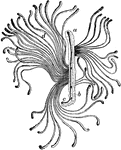
Spruce Beetle
"Galleries of the spruce-destroying beetle beneath the bark of a spruce tree." —Davison, 1906

Stag Beetle
Lucanus Dama, the most common stag beetle in which the mandibles of the male are much enlarged and sickle-shaped;…

Stag Beetle (Lucanus Cervus)
"They live in half rotten trees. Their strength enables them to lift considerable wieghts. They do not…

Subangular Ground Beetle
"Subangular Ground-beetle (Aspidoglossa subangulata). Vertical line shows natural size."-Whitney, 1902

Tiger Beetles
Beetles form a large group of insects that number over 300,000 species. They all have hard wings which…

Tiger Beetle
"Its distinguishing features are its small eyes, separate posterior coxae, and widely inflexed margin…

Tiger Beetle
A beetle with a contignous posterior coxae, large prominent eyes, ad maxillary palpi with the third…

Tiger Beetle
A beetle with a contignous posterior coxae, large prominent eyes, ad maxillary palpi with the third…

Tiger Beetle
A beetle with a contignous posterior coxae, large prominent eyes, ad maxillary palpi with the third…

Tiger Beetle
A beetle with a contignous posterior coxae, large prominent eyes, ad maxillary palpi with the third…

Tiger Beetle (Cicindela Heros)
"Their ferocity is remarkable. They quickly tear off the wings and legs of their victim, and suck out…

Under Side of Pupa of Tiger Beetle (Cicindela Heros)
"Their ferocity is remarkable. They quickly tear off the wings and legs of their victim, and suck out…
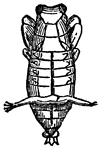
Upper Side of Pupa of Tiger Beetle (Cicindela Heros)
"Their ferocity is remarkable. They quickly tear off the wings and legs of their victim, and suck out…

Tiger Beetle and Larvae
"The common European species, Cincindela campestris, may be found flying and running around…
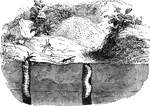
Tiger Beetle Larve
"The common European species, Cincindela campestris, may be found flying and running around…



